Abstract
A method to transform pyridazine N-oxides into 2-aminofurans using a combination of UV light and transition metal catalysis has been developed. These electron-rich species exhibit a surprising range of useful reactivity, including the ability to participate in complexity building cascade processes when reacted with dienophiles. This study also establishes 2-aminofurans as valuable synthons that support modular synthetic entry to the shared heterocyclic core of certain aspidosperma and amaryllidaceae alkaloids.
Graphical Abstract
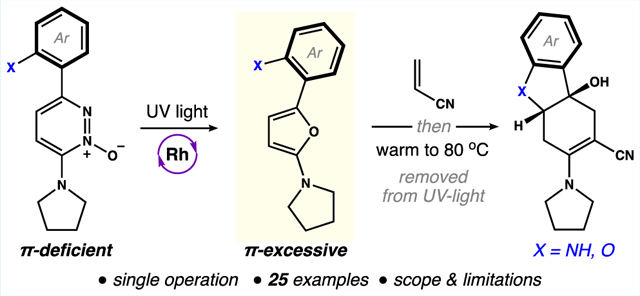
Furans harbor considerable utility as dienes in Diels–Alder reactions despite their aromatic electronic configuration.1 A powerful variant of this chemistry involves the introduction of an amine at the 2-position of the furan nucleus.2 Padwa established that this modification increases the HOMO energy relative to that of furan and, therefore, facilitates [4 + 2] cycloadditions with a range of dienophiles.3 However, in many cases, these electron-rich furans are difficult to isolate or even trap as intermediates in situ.4 As a result, intramolecular reactions of deactivated 2-amidofuran derivatives5,6 are required for most synthetic applications,7,8 leaving the intrinsic reactivity of the parent furan underexplored.9 This limitation became apparent to us during a campaign to develop generalized synthetic entry to the shared heterocyclic nucleus of certain aspidosperma and amaryllidaceae alkaloids (1, Figure 1), wherein an intermolecular 2-aminofuran Diels–Alder reaction was chosen as a part of our strategy.10
Figure 1.
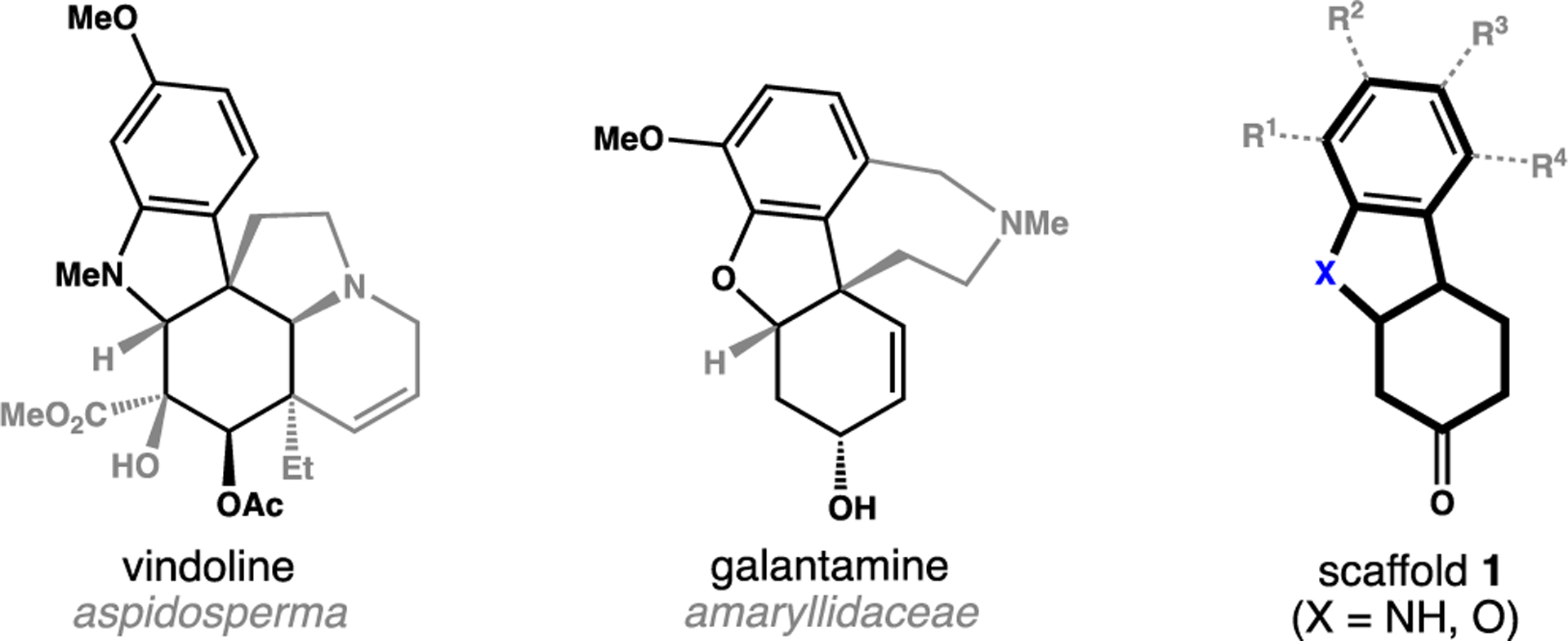
Selected alkaloids containing target substructure 1.
With assembly of scaffold 1 as our goal, we considered that the requisite 2-aminofurans might be prepared from pyridazine N-oxides 2 using photochemistry.11 As shown in Scheme 1, we previously reported that exposure of 3-aryl-6-aminopyridazine N-oxides (e.g., 2a) to UV light generates (Z)-diazoalkenes A, which isomerize to pyrazoles (e.g., 3a) at 65 °C.12 Notably, incorporation of an electron-donating amine substituent to C6 of the pyridazine nucleus was found to be critical for suppressing photodeoxygenation of 2.13 This key feature also slowed competitive decomposition of A to the free carbene, which reportedly generates furan side products (e.g., 5a).14 On the basis of these results, we reasoned that a transition metal catalyst could be used to fully divert intermediate A to 2-aminofuran B via the corresponding metallocarbene.15,16 Once formed, we expected to trap B via cycloaddition with an electron-deficient alkene to afford a reactive oxabicyclo[2.2.1]heptene intermediate.3 Spontaneous ring opening of this species would unveil vinylogous iminium C, allowing cyclization of a pendent nucleophile (X = NH2, OH) to terminate the reaction en route to heterocycles 4. Herein, we report the systematic development of this photoinduced cascade reaction and evaluate its scope and limitations as a modular entry point to substructure 1.
Scheme 1.
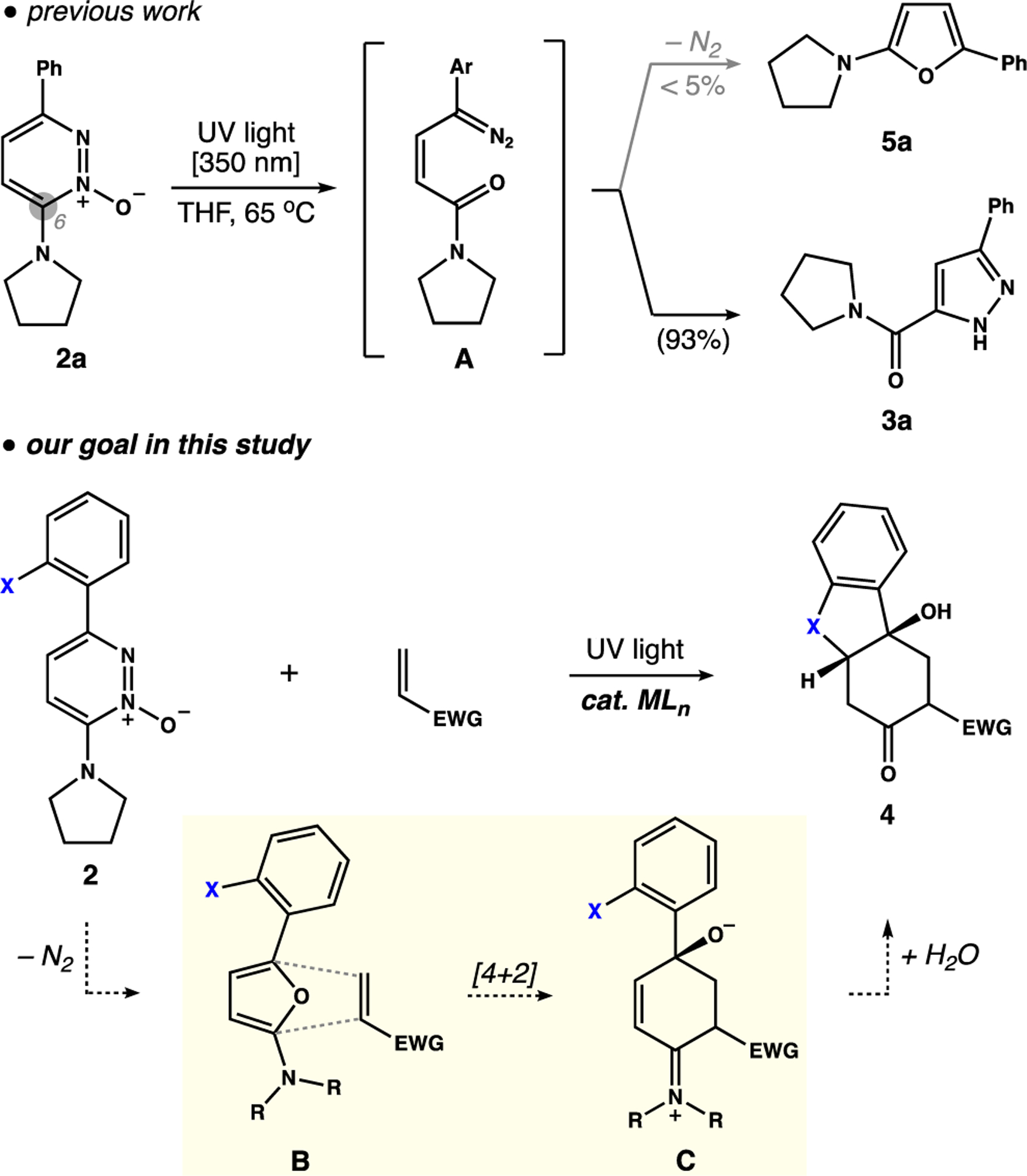
Photoinduced Cascade Reaction To Access Functionalized Variants of Scaffold 1
At the outset, we realized that successful implementation of the strategy outlined in Scheme 1 required a catalyst capable of intercepting A faster than it could isomerize to pyrazole 3. Along these lines, experiments to identify an effective catalyst focused on substrates 2a (X = H) and 2b (X = NH2), which were prepared on gram-scale via a modification of our reported two-step synthesis.12 As outlined in Table 1, photolysis (hν = 350 nm) of 2a at 35 °C in THF (0.3 M) for 2 h afforded pyrazole 3a in 93% yield in the absence of a catalyst (entry 1).17 After an extensive catalyst screen, we found that catalyst systems based on copper or iron exhibited virtually no improvement over the background reaction. In contrast, dirhodium(II) complexes gave furan 5a as the major product under otherwise identical conditions (entries 2–5).18,19 Notably, Rh2(esp)2 emerged as the top performing catalyst from our study, providing furan 5a in 91% yield (entry 5). We also determined that 1 mol % of Rh2(esp)2 was necessary to suppress formation of 3a and give synthetically useful yields of 5a (entry 6).
Table 1.
Summary of Catalyst Optimization Studiesa

| |||||
|---|---|---|---|---|---|
| entry | 2 | catalyst (mol %) | additived,e | 3/5/6f | product (% yield)g |
| 1 | 2a b | none | none | ≥95% 3a | 3a (93) |
| 2 | 2a b | Rh2(OAc)4 (2) | none | 1:3:0 | 5a (nd) |
| 3 | 2a b | Rh2(TFA)4 (2) | none | 1:12:0 | 5a (nd) |
| 4 | 2a b | Rh2(cap)4 (2) | none | 1:4:0 | 5a (nd) |
| 5 | 2a b | Rh2(esp)2 (2) | none | 1:18:0 | 5a (91) |
| 6 | 2a b | Rh2(esp)2 (1) | none | 1:15:0 | 5a (62) |
| 7 | 2b c | none | none | 2:0:1 | 3b (46) |
| 8 | 2b c | Rh2(esp)2 (1) | none | ≥95% 6 | 6 (92) |
| 9 | 2b c | Rh2(esp)2 (3) | K2CO3 | ≥95% 5b | 5b (88)h |
| 10 | 2b c | none | K2CO3 | 1.3:1:0 | 3b (nd) |
| 11 | 2b c | Rh2(esp)2 (3) | Na2CO3 | 1:10:0 | 5b (nd) |
| 12 | 2b c | Rh2(esp)2 (3) | Cs2CO3 | 1:12:4 | 5b (nd) |
| 13 | 2b c | Rh2(esp)2 (3) | Et3N | 2:4:1 | 5b (nd) |
Reactions were carried out on 0.1 mmol scale in a Rayonet using 24 W UV lamps (see the Supporting Information for a description of the reaction setup).
Reaction carried out at 35 °C in THF (0.3 M).
Reaction carried out at 65 °C in THF (0.1 M).
0.5 equiv of additive was used.
Reactions containing inorganic bases were heterogeneous.
The ratio of products was determined by 1H NMR spectroscopy at 400 MHz from unpurified reaction mixtures.
Isolated yield of the indicated major product (nd = not determined).
Compound 5b is reactive; isolated yields varied from 62 to 88%.
Our next experiments targeted the corresponding reaction of N-oxide 2b (X = NH2). This substrate was notably less soluble than 2a. As such, we found that a useful rate of photochemical ring opening was achieved in THF (0.1 M) at 65 °C. Under these modified conditions, irradiation of 2b in the absence of a catalyst afforded pyrazole 3b; however, indole-2-acetamide 6 was observed as an unexpected side product (entry 7). To our surprise, 6 was isolated in 92% yield when 2b was irradiated in the presence of 1 mol % of Rh2(esp)2 (entry 8). We reasoned that 6 might be generated from initially formed furan 5b via acid-catalyzed isomerization. As a result, we examined the utility of bases as additives to suppress this rearrangement. Extensive experimentation revealed that addition of powdered K2CO3 (0.5 equiv) to the reaction media fully inhibited formation of 6 and furnished 5b as the exclusive product when 3 mol % of Rh2(esp)2 was included to suppress the background formation of 3b (entry 9).20,21 Notably, photolysis of 2b in the presence of 0.5 equiv of K2CO3 but without Rh2(esp)2 afforded a 1.3:1 mixture of 3b and 5b (entry 10). The potassium ion also proved to be optimal as evidenced by the inferior results obtained with Na2CO3 and Cs2CO3 (entries 11 and 12). In addition, organic bases such as Et3N afforded complex mixtures of 3b, 5b, and 6 (entry 13).
As summarized in Table 2, we carried out a series of experiments to confirm the origin of indole 6. A key observation was that purified samples of 5b in CDCl3 (0.1 M) isomerized to 6 under ambient laboratory conditions over 6 h (entry 1). The rate of isomerization was unchanged by the presence and rigorous exclusion of oxygen; however, UV light (hν = 350 nm) greatly accelerated the reaction (entry 2).22 In contrast, protecting 5b from light slowed the rearrangement to the extent that only trace amounts of 6 were detected after 6 h (entry 3). The same result was achieved in ambient light when 0.5 equiv of K2CO3 was added to the solution (entry 4). Notably, when a mixture of 5b and 3 mol % of Rh2(esp)2 in CDCl3 was protected from light, we found that indole 6 was formed in 27% yield after 6 h (entry 5). Alternatively, when a solution of 5b was protected from light and then treated with TsOH (10 mol %), we observed rapid formation of indole 6 (entry 6). Taken together, these results are consistent with the scenario wherein 6 arises from 5b via an acid-catalyzed mechanism.
Table 2.
Control Experiments Establishing an Acid-Catalyzed Mechanism for the Rearrangement of Furan 5b to Indole 6
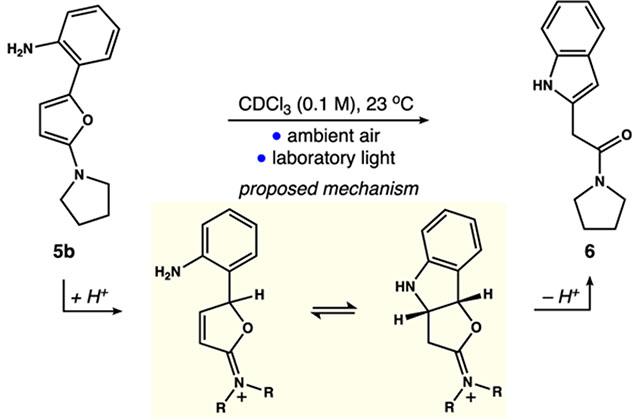
| |||
|---|---|---|---|
| entry | modificationa | time | NMR yield of 6(%)b |
| 1 | none | 6 h | 86 |
| 2 | hν = 350 nm | 5 min | 84 |
| 3 | no light | 6 h | trace |
| 4 | 0.5 equiv of K2CO3 | 6 h | trace |
| 5 | no light, 3 mol % of Rh2(esp)2 | 6 h | 27 |
| 6 | no light, 10 mol % of TsOH | 1 h | 89 |
No light = protected from light with aluminum foil.
Yields determined by 1H NMR (400 MHz) using bibenzyl as an internal standard.
Having established conditions to transform pyridazine N-oxides 2 into 2-aminofurans 5, we turned our attention toward trapping these reactive heterocycles via a Diels–Alder reaction with acrylonitrile. As shown in Scheme 2, our initial experiments focused on N-oxide 2a (X = H). Thus, exposure of a solution of 2a and 1.5 mol % of Rh2(esp)2 in THF (0.3 M) to UV light (hν = 350 nm) at 35 °C (method A) cleanly generated 5a after 3 h. The unpurified reaction mixture was then removed from UV light, treated with acrylonitrile (1.5 equiv), and heated to 80 °C for 10 h. This two-stage procedure afforded dihydrobiaryl 7 in 82% yield.23 In contrast, no reaction occurred when 2a and acrylonitrile (5 equiv) were heated to 80 °C in THF (0.3 M). This control experiment confirms that 2a is not a substrate for Diels–Alder chemistry under the reaction conditions described here.24 Importantly, variants of 2a bearing functionalized arenes were viable substrates (Scheme 2a). Accordingly, cycloadducts containing substituted aryl groups (i.e., 8−11) were formed in good yield. The lone exception was product 12, which was isolated in 30% yield alongside 43% of the corresponding pyrazole (3). This result indicates that the basic pyridine group slows Rh-catalyzed formation of the required 2-aminofuran.
Scheme 2.
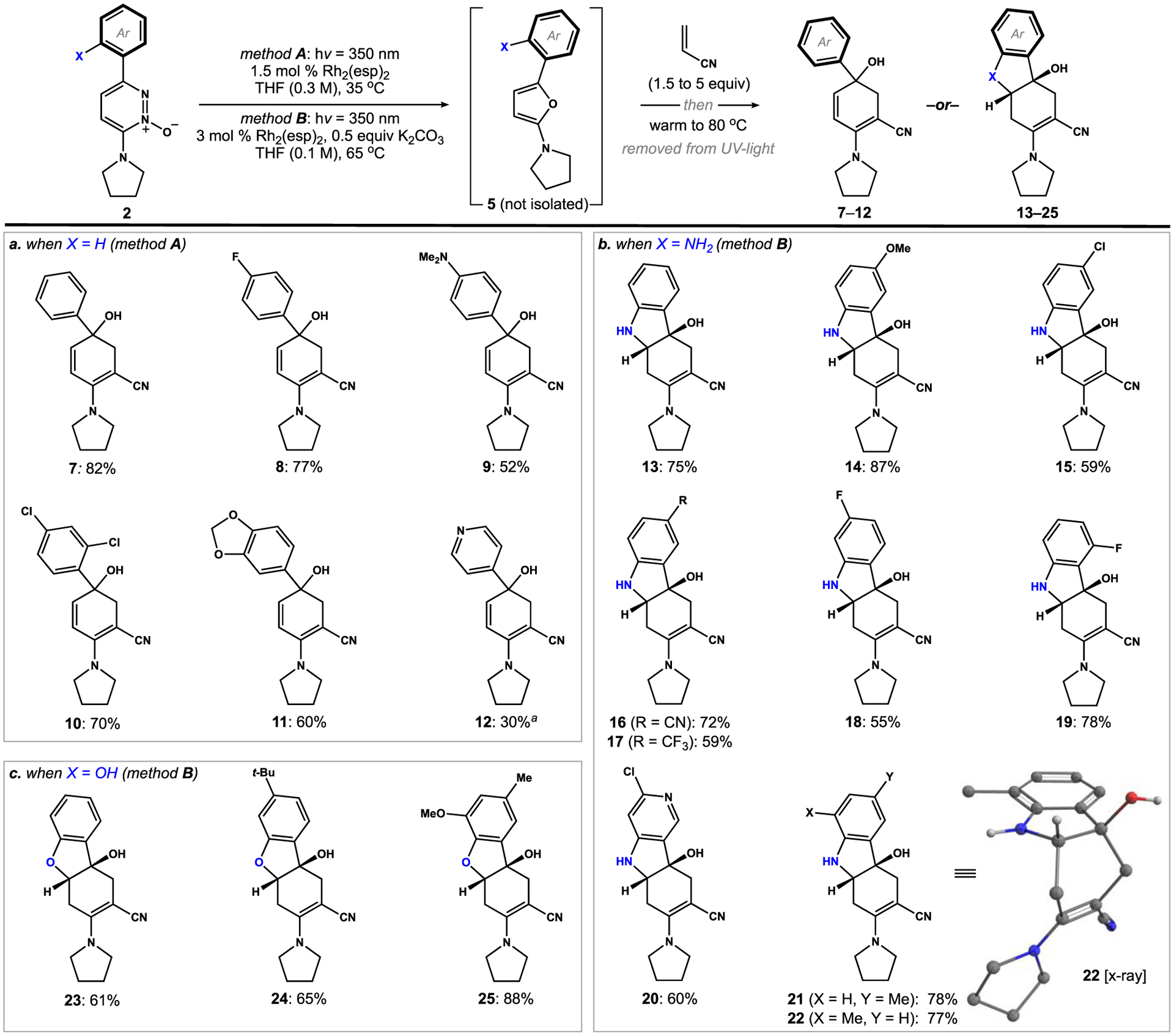
Scope of Complexity Building Cascade Reactions Triggered by Photochemical Ring Opening of Pyridazine N-Oxides 2
a The corresponding pyrazole (3) was isolated in 43% yield.
Next, we explored the reactivity of N-oxide 2b (X = NH2) harboring an amine nucleophile on the arene ring. In this case, 2-aminofuran 5b was generated in situ using K2CO3 as an additive as previously described (method B). This species was then reacted with 5 equiv of acrylonitrile at 80 °C to furnish cis-tetrahydrocarbazole 13 in 75% yield. To our delight, this procedure enabled access to variants of 13 harboring a range of functionality around the aromatic periphery of the tetrahydrocarbazole framework (Scheme 2b). Importantly, the chemistry is tolerant of systems with electron-donating groups (14), electron-withdrawing groups (16 and 17), and nitrogen heterocycles (20). Notably, this method was also compatible with variants of N-oxide 3b (X = OH), which afforded valuable cis-tetrahydrodibenzofuran derivatives 23−25 in good to excellent yield (Scheme 2c).
As shown in Scheme 3, intermolecular Diels–Alder reactions of photochemically generated 2-aminofuran 5b were explored using other dienophiles. Thus, we found that purified 5b could be reacted with phenyl vinyl sulfone in THF at 80 °C to furnish ketone 26 in 68% yield (Scheme 3a). Electron-deficient dienophiles such as (E)-fumaronitrile and dimethyl acetylene-dicarboxylate were also productive cycloaddition partners, affording carbazole derivatives 27 and 28 in good yield. In contrast, more reactive dienophiles gave alternative products. For example, 5b reacted rapidly with N-methylmaleimide at 23 °C to give biaryl 29 in 79% yield. Alternatively, a Diels–Alder reaction was not observed when 5b was treated with 2-propylidenemalonitrile. Instead, alkylated furan 30 was generated as the exclusive product in 60% yield. Taken together, these results highlight the complex reactivity profile of electron-rich heterocycle 5b.
Scheme 3.
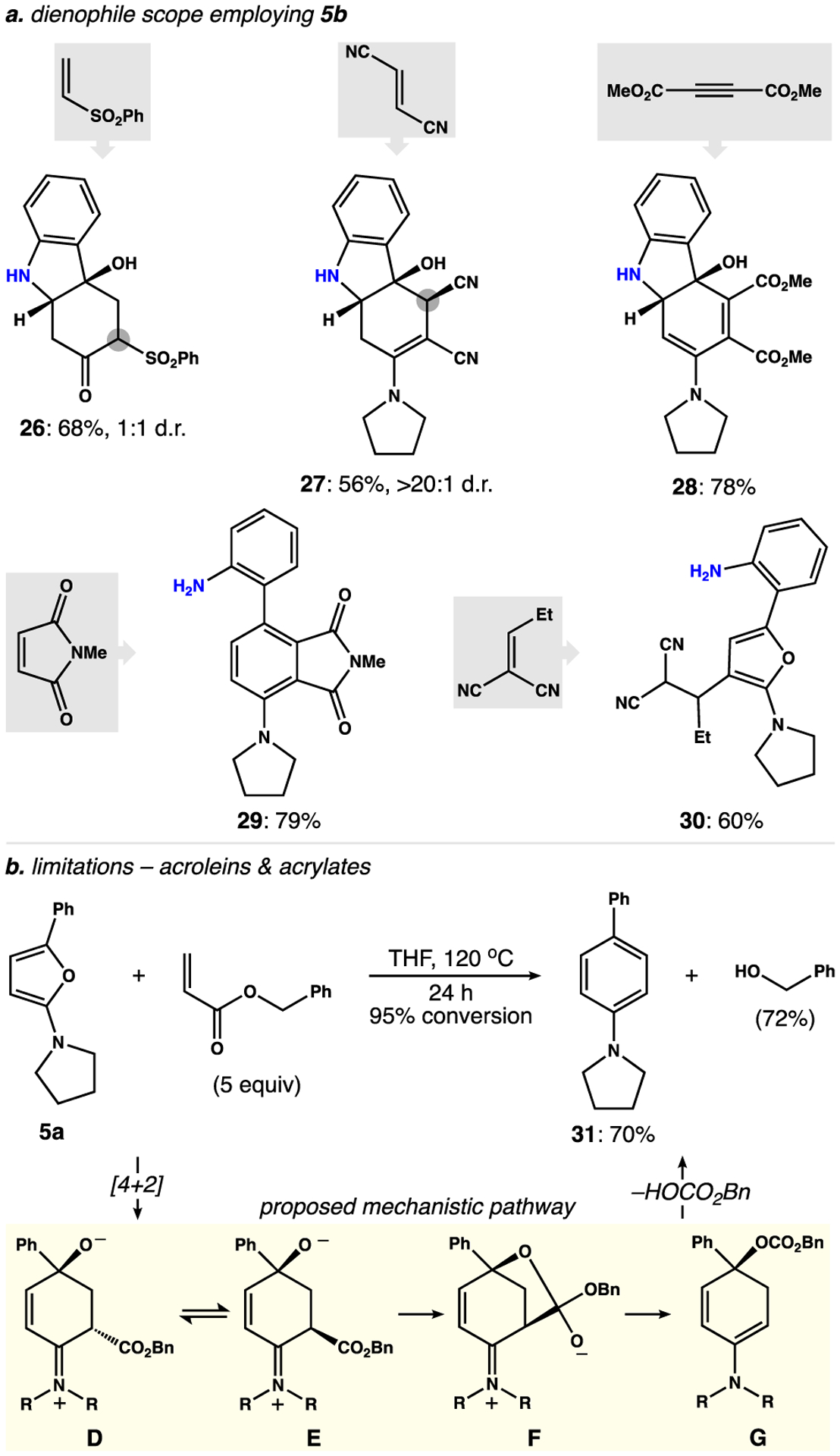
Diels–Alder Reactions between 2-Aminofurans 5a and 5b with Alternative Dienophiles: Scope and Limitations
In further support of this point, we found that acrolein and acrylates gave complex, intractable mixtures of products when reacted with 5b. Moreover, we could not identify any products reminiscent of a carbazole from these reactions. To probe this limitation further, we explored the reactivity of furan 5a with this subclass of dienophiles. To our surprise, exposure of 5a to either acrolein or methyl acrylate afforded aniline derivative 31, wherein the carbonyl group was lost altogether. We probed the mechanism of this unexpected transformation by reacting 5a with benzyl acrylate (5 equiv) in THF at 120 °C. This reaction cleanly afforded an equimolar mixture of 31 and benzyl alcohol (see the Supporting Information for details). As shown in Scheme 3b, we propose a mechanism to rationalize this result wherein the initial Diels–Alder reaction gives rise to an equilibrium of intermediates D and E. Intramolecular capture of the ester within E by the pendent alkoxide gives rise to intermediate F, which collapses to afford tertiary carbonate G. Subsequent elimination of benzyl hydrogen carbonate25 then restores aromaticity en route to arene 31.
In summary, we have developed a new method to convert pyridazine N-oxides 2 to 2-aminofurans 5 using a combination of UV light and rhodium catalysis. These electron-rich heterocycles exhibit a surprising range of synthetically useful reactivity. Importantly, our work highlights the utility of elusive 2-aminofurans in intermolecular Diels–Alder reactions with simple alkenes. Moreover, when designed appropriately, this reaction manifold can be leveraged to provide practical entry to functionalized carbazole and dibenzofuran motifs that would be difficult or impossible to prepare by other means. Efforts to adapt and extend this methodology to the total syntheses of the aspidosperma and amaryllidaceae alkaloids described in Figure 1 are ongoing in our laboratory.
Supplementary Material
ACKNOWLEDGMENTS
This work was supported by Florida State University (FSU). We thank Michael Maxwell (FSU), Daniel Callen (FSU), and Elena Paola (FSU) for assistance with substrate synthesis. Mass spectra were collected, in part, at the University of Florida (UF) using NIH-sponsored equipment (S10-OD021751-A1).
Footnotes
The authors declare no competing financial interest.
Supporting Information
The Supporting Information is available free of charge on the ACS Publications website at DOI: 10.1021/acs.orglett.9b00682.
Experimental details and NMR spectra (PDF)
Accession Codes
CCDC 1895817 contains the supplementary crystallographic data for this paper. These data can be obtained free of charge via www.ccdc.cam.ac.uk/data_request/cif, or by emailing data_request@ccdc.cam.ac.uk, or by contacting The Cambridge Crystallographic Data Centre, 12 Union Road, Cambridge CB2 1EZ, UK; fax: +44 1223 336033.
REFERENCES
- (1).For reviews on the Diels–Alder reaction of furan, see; (a) Lreipshutz BH Chem. Rev 1986, 86, 795. [Google Scholar]; (b) Kappe CO; Murphree SS; Padwa A Tetrahedron 1997, 53, 14179. [Google Scholar]
- (2).Padwa A; Flick AC Adv. Heterocycl. Chem 2013, 110, 1. [Google Scholar]
- (3).(a) Padwa A; Dimitroff M; Waterson AG; Wu TJ Org. Chem 1997, 62, 4088. [Google Scholar]; (b) Padwa A; Dimitroff M; Waterson AG; Wu TJ Org. Chem 1998, 63, 3986. [Google Scholar]
- (4).(a) Vargha L; Ramonczai J; Bite P J. Am. Chem. Soc 1948, 70, 371. [DOI] [PubMed] [Google Scholar]; (b) Ito K; Yakushijin K Heterocycles 1978, 9, 1603. [Google Scholar]; (c) Bobosikova M; Clegg W; Coles SJ; Dandarova M; Hursthouse MB; Kiss T; Krutosikova A; Liptaj T; Pronayova N; Ramsden CA J. Chem. Soc., Perkin Trans 2001, 1, 680. [Google Scholar]; (d) Quai M; Frattini S; Vendrame U; Mondoni M; Dossena S; Cereda E Tetrahedron Lett 2004, 45, 1413. [Google Scholar]
- (5).Padwa A; Crawford KR; Rashatasakhon P; Rose MJ Org. Chem 2003, 68, 2609. [DOI] [PubMed] [Google Scholar]
- (6).The alternative strategy of adding an electron-withdrawing group to the furan nucleus is also effective:; (a) Mossetti R; Caprioglio D; Colombano G; Tron GC; Pirali T Org. Biomol. Chem 2011, 9, 1627. [DOI] [PubMed] [Google Scholar]; (b) Jiang Y; Khong VZY; Lourdusamy E; Park C-M Chem. Commun 2012, 48, 3133. [DOI] [PubMed] [Google Scholar]
- (7).For select examples in heterocycle synthesis, see:; (a) Medimagh R; Marque S; Prim D; Chatti S; Zarrouk HJ Org. Chem 2008, 73, 2191. [DOI] [PubMed] [Google Scholar]; (b) Kiren S; Hong X; Leverett CA; Padwa A Org. Lett 2009, 11, 1233. [DOI] [PubMed] [Google Scholar]; (c) Xu J; Wipf P Org. Biomol. Chem 2017, 15, 7093. [DOI] [PubMed] [Google Scholar]
- (8).For select examples in natural product total synthesis, see:; (a) Trost BM; McDougall PJ Org. Lett 2009, 11, 3782. [DOI] [PMC free article] [PubMed] [Google Scholar]; (b) Petronijevic FR; Wipf P J. Am. Chem. Soc 2011, 133, 7704. [DOI] [PMC free article] [PubMed] [Google Scholar]; (c) Li G; Padwa A Org. Lett 2011, 13, 3767. [DOI] [PubMed] [Google Scholar]
- (9).For generalized methods to prepare 2-aminofurans, see:; (a) Nair V; Vinod AU Chem. Commun 2000, 1019. [Google Scholar]; (b) Liu P; Lei M; Ma L; Hu L Synlett 2011, 2011, 1133. [Google Scholar]; (c) Kondoh A; Ishikawa S; Aoki T; Terada M Chem. Commun 2016, 52, 12513. [DOI] [PubMed] [Google Scholar]; (d) Mahida AK; Kale SB; Das U Eur J Org. Chem 2017, 2017, 6427. [Google Scholar]
- (10).For a report of intermolecular [4 + 2] cycloadditions involving 2-aminofurans, see:; Neo AG; Bornadiego A; Diaz J; Marcaccini S; Marcos CF Org. Biomol. Chem 2013, 11, 6546. [DOI] [PubMed] [Google Scholar]
- (11).For early reports on the photochemical ring opening of pyridazine N-oxides, see:; (a) Kumler PL; Buchardt O J. Am. Chem. Soc 1968, 90, 5640. [Google Scholar]; (b) Tomer KB; Harrit N; Rosenthal I; Buchardt O; Kumler PL; Creed D J. Am. Chem. Soc 1973, 95, 7402. [Google Scholar]
- (12).Portillo M; Maxwell MA; Frederich JH Org. Lett 2016, 18, 5142. [DOI] [PubMed] [Google Scholar]
- (13).For reports on the photodeoxygenation of pyridazine N-oxides, see:; (a) Ogata M; Kano K Chem. Commun 1967, 1176. [Google Scholar]; (b) Tsuchiya T; Arai H; Igeta H Tetrahedron Lett 1969, 10, 2747. [DOI] [PubMed] [Google Scholar]; (c) Tsuchiya T; Arai H; Igeta H J. Chem. Soc., Chem. Commun 1972, 550. [Google Scholar]
- (14). Furans have been reported as side products of pyridazine N-oxide photochemistry. For examples, see ref 11b and.; Ogawa Y; Iwasaki S; Okuda S Tetrahedron Lett 1981, 22, 2277. [Google Scholar]
- (15).Padwa A; Weingarten DM Chem. Rev 1996, 96, 223. [DOI] [PubMed] [Google Scholar]
- (16).Johnson T; Cheshire DR; Stocks MJ; Thurston VT Synlett 2001, 2001, 0646. [Google Scholar]
- (17). Photoreactions were carried out in a Rayonet chamber reactor equipped with 24 W UV lamps wherein ~90% of emission is 350 nm. Reactions were conducted in 1-dram borosilicate vials using untreated THF under ambient atmosphere. See the Supporting Information for details regarding the reaction setup.
- (18). As expected, furans 5a and 5b were labile. However, they could be purified using silica gel and stored at −20 °C for 24–48 h. The half-lives of these species at rt and 80 °C are reported in the Supporting Information.
- (19). Consistent with ref 12, secondary amines such as morpholine are tolerated in this chemistry; however, pyrrolidine gave the best results in our experiments. A complete report on the scope and limitations of electron-donating groups at C6 of the pyridazine nucleus is forth-coming.
- (20). Lower catalyst loadings (1–2.5 mol %) gave mixtures of 5b and pyrazole 3b. See the Supporting Information for details on optimization of catalyst loading.
- (21). Powered KOH and K3PO4 gave results comparable to those of K2CO3. A comprehensive screen of inorganic bases is reported in the Supporting Information.
- (22).No photochemical rate acceleration was observed when the reaction was performed in THF-d6. We suspect this rate acceleration is the result of trace HCl generated by photodecomposition of chloroform:; Hill DG J. Am. Chem. Soc 1932, 54, 32. [Google Scholar]
- (23).Product 7 was isolated in identical yield when acrylonitrile (1.5 equiv) was included in the photochemical step; however, this modification resulted in a prolonged photoirradiation time of 9 h.
- (24).Pyridazines have been used as 4π-diene components in Diels–Alder reactions; however, these cycloadditions require increased temperature or catalytic activation of the diazine. For examples, see:; (a) Boger DL; Coleman RS J. Org. Chem 1984, 49, 2240. [Google Scholar]; (b) Kessler SN; Wegner HA Org. Lett 2010, 12, 4062. [DOI] [PubMed] [Google Scholar]
- (25).Benzyl hydrogen carbonate was not detected by 1H NMR spectroscopy (400 MHz) of the unpurified reaction mixture. Instead, this species undergoes decarboxylation to give benzyl alcohol:; Pocker Y; Davison BL; Deits TL J. Am. Chem. Soc 1978, 100, 3564. [Google Scholar]
Associated Data
This section collects any data citations, data availability statements, or supplementary materials included in this article.


